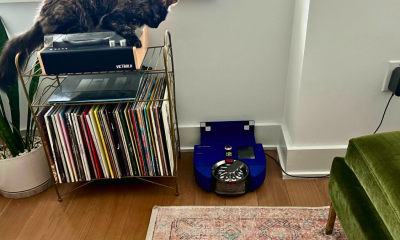Technology
Why Shake Alert app didn’t warn users before 2 major earthquakes

The two earthquakes many Angelenos felt over the Fourth of July weekend weren’t just cause for the usual excitement, curiosity, or even fear last week. They also inspired anger.
Angelenos received no warning about the temblors from an alert app introduced earlier this year that was marketed as the country’s first early warning system for earthquakes. That caused some to express frustration at the city and mayor on social media, even though officials say the app was working as it should.
Although the 7.1 and 6.4 quakes caused considerable damage near their origin about 100 miles away in Ridgecrest, the shaking in LA didn’t meet the app’s threshold for an alert.
Now, city officials are making changes to the Shake Alert LA app to give the public more information when lower-intensity quakes, like those experienced last week, strike.
That change could have bigger implications for the role technology can play — whether it has the potential to help, annoy, or harm — in the event of a California shaker. It also shows that perfecting the earthquake warning app will take some public trial and error.
When the public talks about earthquakes, we generally refer to the magnitude. But magnitude isn’t necessarily the best way to understand how earthquakes affect the ground beneath our feet.
Instead, seismologists use a metric for “intensity,” which describes how earthquakes feel for a person in a given place, and not just the strength at the source. Intensity has to do with a lot of things, including your distance from the origin of the earthquake, the kind of waves the earthquake produces, and more.
To quantify intensity, the U.S. Geological Survey (USGS) uses a system called the Modified Mercalli Intensity Scale. Numbers — ranging from the low, barely detectable 1, through the literally Earth shattering 10 — describe how an earthquake feels, and what it’s likely to affect, at a given location. This is the scale that Shake Alert LA runs on.
When designing Shake Alert LA, the city and the USGS agreed that it would deliver alerts when an earthquake with an estimated intensity of 4 or above was on the way.
“The policy decision we made is that we didn’t want to alert people unless they would experience potentially damaging shaking,” Robert de Groot, the national coordinator of outreach and education for Shake Alert at the USGS told Mashable. “At level 4, that’s where that level of shaking begins. At level 3, it’s just minor light shaking. It doesn’t do much.”
That policy decision played out in real time during the recent earthquakes. Because the holiday earthquakes were so far away, neither qualified as a 4 in LA. Instead, with light shaking that was felt, but didn’t inflict much damage, they qualified as 3s. So, Shake Alert didn’t send out a notification. Or, as Shake Alert wrote on Twitter, it “performed as designed.”
“Shake Alert is about shaking, it’s about how the ground moves,” de Groot said. “What we’re concerned about is the shaking that that magnitude 7.1 releases, and where that shaking is.”
But negative reactions to the lack of warning have prompted changes.
So the app did nothing during today’s quake and therefore “performed as designed”. Seems like a pretty low bar to achieve.
— Kyle Krupinski (@KyleKrupinski) July 4, 2019
The USGS and city officials agreed over the weekend that Shake Alert would begin to notify users in the case of intensity level 3 quakes or above.
“The general feeling that we’re getting from the public is that they would like to know that something is happening, even if it’s only light shaking,” de Groot said.
One month prior, the USGS made another tweak to the app, which was completely unrelated to a recent quake. Now Shake Alert gets earthquake information for magnitude 4.5 events or above, before the threshold for that was magnitude 5. (Remember there’s a difference between magnitude and intensity). That adjustment won’t have a significant effect on operations, de Groot said, because the change is minimal.
The more significant change, instead, is the new intensity tweak. Lowering the intensity bar changes the actual purpose of the app from a service that would deliver a notification about impending potential danger to one that will send alerts about minor shakes and big events alike.
“If people want that, they should have it,” John Vidale, director of the Southern California Earthquake Center, told Mashable. “I think it’s very reassuring when one feels an earthquake to know what happened quickly. I think it’s as valuable to know when it’s not a bad earthquake than just when a bad earthquake happens.”
However, changing the notification threshold from a 4 to a 3 comes with some risks. People are prone to get a lot more notifications, since low-intensity events are much more common than potentially dangerous shakes.
In addition to changing the nature of the app, the new notification bar could become annoying or even lead people to discount notifications for a significant event as they begin to associate the app with minor events.
“It’s a little tricky, because people don’t always know what will most benefit them when there’s a dangerous situation like an earthquake,” Vidale said. “We don’t want people that unintentionally drive the system in a bad way. But wanting to know about moderate shaking seems like a legitimate request to me.”
As the first notification system of its kind in the U.S. (there are similar systems in other countries), how the public reacts to Shake Alert may influence the design of systems across the country; the hope is to expand similar systems across the West Coast. But with input from the public, scientists, and politicians, the role technology can play in riding out earthquakes is still a work in progress.
“It’s bound to evolve a lot in the next couple of years,” Vidale said. “Everyone can see the potential now. But actually having alerts in a timely way is something where there’s going to be a lot of people improving it in a lot of ways.”

-

 Business4 days ago
Business4 days agoAPI startup Noname Security nears $500M deal to sell itself to Akamai
-

 Business6 days ago
Business6 days agoYoshi Mobility has come a long way since gassing up cars on the side of the road
-

 Entertainment4 days ago
Entertainment4 days agoHow to watch ‘Argylle’: When and where is it streaming?
-

 Entertainment3 days ago
Entertainment3 days agoNASA discovered bacteria that wouldn’t die. Now it’s boosting sunscreen.
-

 Business4 days ago
Business4 days agoUS think tank Heritage Foundation hit by cyberattack
-

 Entertainment3 days ago
Entertainment3 days agoDyson 360 Vis Nav robot vacuum review: Dyson should just stick to upright vacuums
-

 Business3 days ago
Business3 days agoTesla drops prices, Meta confirms Llama 3 release, and Apple allows emulators in the App Store
-

 Entertainment4 days ago
Entertainment4 days agoCrypto and taxes: Which forms you need to file



















